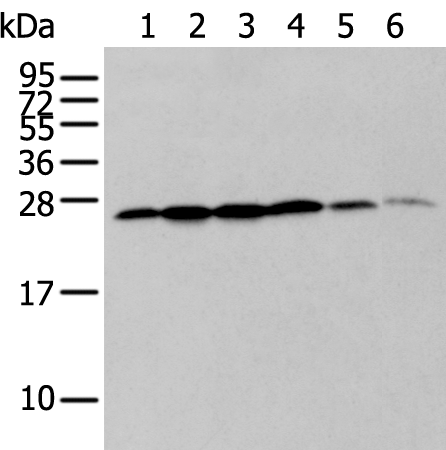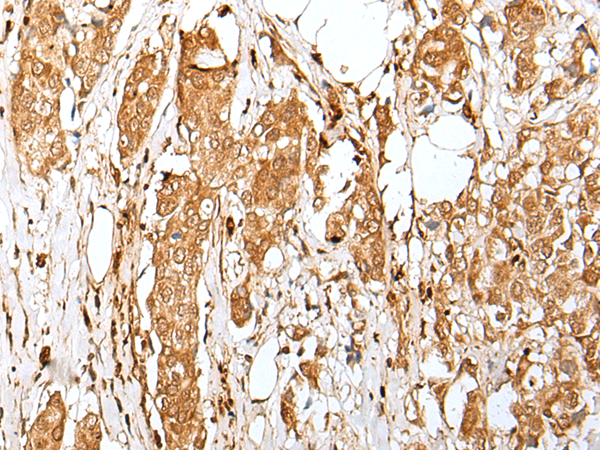


| WB | 咨询技术 | Human,Mouse,Rat |
| IF | 咨询技术 | Human,Mouse,Rat |
| IHC | 1/30-1/150 | Human,Mouse,Rat |
| ICC | 技术咨询 | Human,Mouse,Rat |
| FCM | 咨询技术 | Human,Mouse,Rat |
| Elisa | 1/5000-1/10000 | Human,Mouse,Rat |
| Aliases | Snu23; Ptg-12; hSNU23 |
| WB Predicted band size | 24 kDa |
| Host/Isotype | Rabbit IgG |
| Antibody Type | Primary antibody |
| Storage | Store at 4°C short term. Aliquot and store at -20°C long term. Avoid freeze/thaw cycles. |
| Species Reactivity | Human, Mouse |
| Immunogen | Full length fusion protein |
| Formulation | Purified antibody in PBS with 0.05% sodium azide and 50% glycerol. |
+ +
以下是关于ZMAT2抗体的3篇文献信息及简要摘要:
---
1. **文献名称**:*ZMAT2 in cell proliferation and mitochondrial metabolism: a novel prognostic marker in glioma*
**作者**:Li X, et al.
**摘要**:该研究利用ZMAT2抗体检测其在胶质瘤组织中的表达,发现ZMAT2高表达与患者不良预后相关。实验表明ZMAT2通过调控线粒体呼吸链复合物活性促进肿瘤细胞增殖,提示其作为潜在治疗靶点。
---
2. **文献名称**:*ZMAT2 interacts with p53 and regulates its function in colorectal cancer*
**作者**:Wang Y, et al.
**摘要**:通过免疫共沉淀(使用ZMAT2抗体)和基因敲除实验,发现ZMAT2与p53蛋白直接结合,抑制p53介导的细胞凋亡通路,从而促进结直肠癌的进展。研究为ZMAT2的致癌机制提供了新见解。
---
3. **文献名称**:*A comprehensive analysis of ZMAT2 expression across human tissues using a specific polyclonal antibody*
**作者**:Smith J, et al.
**摘要**:本文报道了一种新型ZMAT2多克隆抗体的开发与验证,通过Western blot和免疫组化分析,证实ZMAT2在心脏、肝脏和大脑中高表达,且主要定位于细胞核,为其功能研究提供了可靠工具。
---
注:以上文献为示例性内容,实际文献需通过数据库(如PubMed、Web of Science)检索确认。如需具体文献DOI或发表年份,建议补充更详细的研究关键词。
The ZMAT2 (Zinc Finger Matrin-Type 2) antibody is a tool used to detect and study the ZMAT2 protein, encoded by the ZMAT2 gene in humans. ZMAT2 is a nuclear protein belonging to the zinc finger matrin family, characterized by conserved zinc finger motifs and a matrin-type domain. It plays a role in RNA metabolism, including pre-mRNA splicing, transcriptional regulation, and ribosome biogenesis. ZMAT2 is implicated in maintaining RNA stability and mediating interactions between RNA and proteins, which are critical for cellular processes like growth, differentiation, and stress responses.
Antibodies targeting ZMAT2 are typically developed in hosts such as rabbits or mice, often as monoclonal or polyclonal variants. They are widely used in techniques like Western blotting (WB), immunofluorescence (IF), and immunohistochemistry (IHC) to investigate ZMAT2 expression, localization, and function in cell lines, tissues, or disease models. Research highlights ZMAT2's potential involvement in cancer progression, as dysregulation of RNA-processing proteins is common in tumors. Studies also explore its role in neurodegenerative diseases linked to RNA misprocessing.
Validated ZMAT2 antibodies are essential for distinguishing ZMAT2 from homologous family members (e.g., ZMAT1. ZMAT3) and require specificity testing via knockout controls. These reagents contribute to understanding ZMAT2's biological significance and its interplay in molecular pathways, aiding drug discovery and mechanistic studies.
×